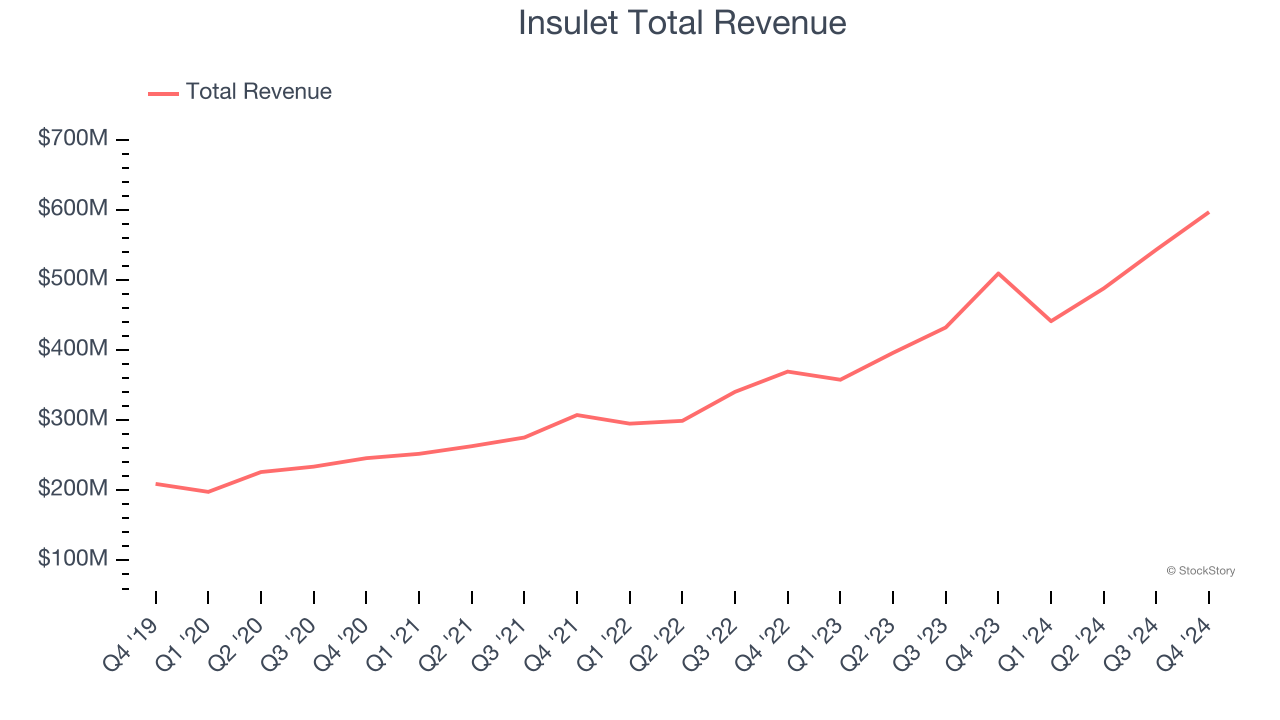
Let’s dig into the relative performance of Masimo (NASDAQ:MASI) and its peers as we unravel the now-completed Q4 patient monitoring earnings season.
Patient monitoring companies within the healthcare equipment industry offer devices and technologies that track chronic conditions and support real-time health management, such as continuous glucose monitors (CGMs) and sleep apnea machines. These businesses benefit from recurring revenue from consumables and software subscriptions tied to device sales (razor, razor blade model). The rising prevalence of chronic diseases like diabetes and respiratory disorders due to an aging population as well as growing adoption of digitization are good for the industry. However, these companies face challenges from high R&D costs and reliance on regulatory approvals. Looking ahead, the sector is positioned for growth due to tailwinds like the rising burden of chronic diseases from an aging population, the shift toward value-based care, and increased adoption of digital health solutions. Innovations in AI and machine learning are expected to enhance device accuracy and functionality, improving patient outcomes and driving demand. However, there are headwinds such as pricing pressures as healthcare costs are a key focus, especially in the US. An evolving regulatory landscape and competition from more tech-forward new entrants could present additional challenges.
The 5 patient monitoring stocks we track reported a strong Q4. As a group, revenues beat analysts’ consensus estimates by 1.9% while next quarter’s revenue guidance was in line.
Amidst this news, share prices of the companies have had a rough stretch. On average, they are down 13.1% since the latest earnings results.
Best Q4: Masimo (NASDAQ:MASI)
Founded in 1989 to solve the "unsolvable problem" of accurate pulse oximetry during patient movement, Masimo (NASDAQ:MASI) develops and manufactures noninvasive patient monitoring technologies, including its breakthrough pulse oximetry systems that accurately measure blood oxygen levels even during patient movement.
Masimo reported revenues of $600.7 million, up 9.4% year on year. This print exceeded analysts’ expectations by 1.5%. Overall, it was an exceptional quarter for the company with an impressive beat of analysts’ EPS estimates and full-year operating income guidance exceeding analysts’ expectations.
Katie Szyman, Chief Executive Officer of Masimo, said “I am extremely excited about the opportunity to lead such an innovative organization as we refocus on our core healthcare business. There are numerous unmet clinical needs that we are well-positioned to address and we have strong momentum behind us. I look forward to interfacing with our customers and discussing our differentiated solutions for patient care. Our 2024 results clearly demonstrate the strong growth and earnings power of our healthcare business. We had a record year in terms of gaining share through customer contracts. As a result of our strategic realignment efforts in the fourth quarter, we expect to see increased earnings and cash flow in 2025 and beyond.”

The stock is down 7.9% since reporting and currently trades at $155.78.
Is now the time to buy Masimo? Access our full analysis of the earnings results here, it’s free.
Insulet (NASDAQ:PODD)
Revolutionizing diabetes care with its tubeless "Pod" technology, Insulet (NASDAQ:PODD) develops and manufactures innovative insulin delivery systems for people with diabetes, primarily through its Omnipod product line.
Insulet reported revenues of $597.5 million, up 17.2% year on year, outperforming analysts’ expectations by 2.5%. The business had a very strong quarter with an impressive beat of analysts’ constant currency revenue and EPS estimates.

The stock is down 10.2% since reporting. It currently trades at $259.01.
Is now the time to buy Insulet? Access our full analysis of the earnings results here, it’s free.
Slowest Q4: DexCom (NASDAQ:DXCM)
Founded in 1999 and receiving its first FDA approval in 2006, DexCom (NASDAQ:DXCM) develops and sells continuous glucose monitoring systems that allow people with diabetes to track their blood sugar levels without repeated finger pricks.
DexCom reported revenues of $1.11 billion, up 7.6% year on year, exceeding analysts’ expectations by 0.9%. Still, it was a slower quarter as it posted a significant miss of analysts’ EPS estimates.
DexCom delivered the weakest performance against analyst estimates, slowest revenue growth, and weakest full-year guidance update in the group. The stock is down 25.7% since the results and currently trades at $62.45.
Read our full analysis of DexCom’s results here.
iRhythm (NASDAQ:IRTC)
Pioneering the shift from bulky, short-term heart monitors to sleek, wire-free patches, iRhythm Technologies (NASDAQ:IRTC) provides wearable cardiac monitoring devices and AI-powered analysis services that help physicians detect and diagnose heart rhythm disorders.
iRhythm reported revenues of $164.3 million, up 24% year on year. This number topped analysts’ expectations by 3.9%. Overall, it was a very strong quarter as it also logged a solid beat of analysts’ EPS estimates.
iRhythm scored the biggest analyst estimates beat, fastest revenue growth, and highest full-year guidance raise among its peers. The stock is down 4.8% since reporting and currently trades at $107.
Read our full, actionable report on iRhythm here, it’s free.
ResMed (NYSE:RMD)
Founded in 1989 to address the then-underdiagnosed condition of sleep apnea, ResMed (NYSE:RMD) develops cloud-connected medical devices and software solutions that treat sleep apnea, COPD, and other respiratory disorders for home and clinical use.
ResMed reported revenues of $1.28 billion, up 10.3% year on year. This result beat analysts’ expectations by 1%. It was a strong quarter as it also recorded a narrow beat of analysts’ constant currency revenue estimates and a decent beat of analysts’ EPS estimates.
The stock is down 16.6% since reporting and currently trades at $214.69.
Read our full, actionable report on ResMed here, it’s free.
Market Update
Thanks to the Fed’s series of rate hikes in 2022 and 2023, inflation has cooled significantly from its post-pandemic highs, drawing closer to the 2% goal. This disinflation has occurred without severely impacting economic growth, suggesting the success of a soft landing. The stock market thrived in 2024, spurred by recent rate cuts (0.5% in September and 0.25% in November), and a notable surge followed Donald Trump’s presidential election win in November, propelling indices to historic highs. Nonetheless, the outlook for 2025 remains clouded by potential trade policy changes and corporate tax discussions, which could impact business confidence and growth. The path forward holds both optimism and caution as new policies take shape.
Want to invest in winners with rock-solid fundamentals? Check out our Top 5 Growth Stocks and add them to your watchlist. These companies are poised for growth regardless of the political or macroeconomic climate.
Join Paid Stock Investor Research
Help us make StockStory more helpful to investors like yourself. Join our paid user research session and receive a $50 Amazon gift card for your opinions. Sign up here.
